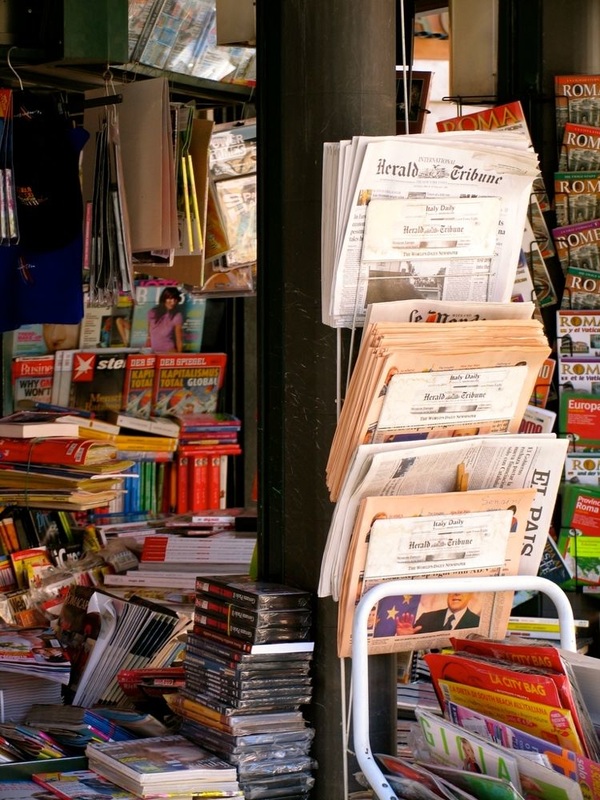Too Much Information - How Do You Figure Out the Nonsense?
Media can put countries, companies or just individuals at a terrible disadvantage by just choosing which bits of information to highlight and which set of adjectives to use.
Reporters desperately want to be noticed and pushing the edges of a story is just the way to get their little bite on the news, beating out the other reporters.
And who picks from among all the stories available to a network? Lining up attack after discrediting attack is called propaganda during war, and news the rest of the time.
And who picks from among all the stories available to a network? Lining up attack after discrediting attack is called propaganda during war, and news the rest of the time.
Of course, media can be very effective in bringing out issues that are often hidden and buried so as not to disturb the status quo. But for every Watergate there are dozens of “notice me, notice me” howls from prancing reporters.
Whatever the case may be, the fact is the media more than any other institution, uses information as their lever for a whole stable of attitudes and objectives they may want to support at the moment.
How do you sort out the nonsense from the occasional gem? How do you figure out what is reality and what is just another snake oil specialist pimping his idea or stock or problem? Believe it or not, you have to assess the truth!
Whatever the case may be, the fact is the media more than any other institution, uses information as their lever for a whole stable of attitudes and objectives they may want to support at the moment.
How do you sort out the nonsense from the occasional gem? How do you figure out what is reality and what is just another snake oil specialist pimping his idea or stock or problem? Believe it or not, you have to assess the truth!
Tell Yourself the Truth
There are many times when you fail to see a number of things within your environment.
Sometimes, you look for your glasses only to find they are on top of your head. Or the white cutting board standing on a white tile. Or when you are so focused on a monument, you fail to see the twit who passed by and took your camera from your packet.
There are dozens of things going on around you, and even if you look, you don’t see. But you can do much better!
How do you trigger onto what you must see in all the clutter there is to look at? Practice…shift your mind out of neutral…each thing you hear, assess in the mirror of your own experience.
Work on your awareness. Train yourself to be more mindful, more present to your environment, to see what is at the periphery of your vision and notice what you don’t expect. You don’t need to be a secret service operative to have heightened situational awareness.
There are many times when you fail to see a number of things within your environment.
Sometimes, you look for your glasses only to find they are on top of your head. Or the white cutting board standing on a white tile. Or when you are so focused on a monument, you fail to see the twit who passed by and took your camera from your packet.
There are dozens of things going on around you, and even if you look, you don’t see. But you can do much better!
How do you trigger onto what you must see in all the clutter there is to look at? Practice…shift your mind out of neutral…each thing you hear, assess in the mirror of your own experience.
Work on your awareness. Train yourself to be more mindful, more present to your environment, to see what is at the periphery of your vision and notice what you don’t expect. You don’t need to be a secret service operative to have heightened situational awareness.
Pick Out Information That Are Solid
Seeing so much is, at times, also a hindrance to your decision making. It can paralyze and prevent you from making a decision. You must have met people who just keep gathering information or trying out things because they cannot commit to a decision.
First, broaden your awareness and then target observable information. Train yourself to pick out the information that are solid, not the opinion of some doofus trying to save his job or sell a new stock.
Always have a list of the relevant information you want to pick out but let yourself be surprised. If something unusual gets your attention, give it a second look. Intuition is not all hooey. The sixth sense is often based on some tiny piece of an idea that is a winner.
Seeing so much is, at times, also a hindrance to your decision making. It can paralyze and prevent you from making a decision. You must have met people who just keep gathering information or trying out things because they cannot commit to a decision.
First, broaden your awareness and then target observable information. Train yourself to pick out the information that are solid, not the opinion of some doofus trying to save his job or sell a new stock.
Always have a list of the relevant information you want to pick out but let yourself be surprised. If something unusual gets your attention, give it a second look. Intuition is not all hooey. The sixth sense is often based on some tiny piece of an idea that is a winner.
Cross Out Irrelevant Data
Too much data does NOT help. Don’t let all the hype and opinion overwhelm you. Go over the information and just cross out irrelevant data or stuff that just doesn’t fit your own judgement framework. This way, you unclutter your mind.
Go through your list another time and let the strategic and highly relevant ones come to the surface. As the sparrows know, somewhere in all that manure there is sure to be some corn or barley!
Too much data does NOT help. Don’t let all the hype and opinion overwhelm you. Go over the information and just cross out irrelevant data or stuff that just doesn’t fit your own judgement framework. This way, you unclutter your mind.
Go through your list another time and let the strategic and highly relevant ones come to the surface. As the sparrows know, somewhere in all that manure there is sure to be some corn or barley!
Allow for Unique Perspectives
People have different perspectives even if both of you were present in the same situation. You bring your whole history to everything you see or hear and your history is unique.
It is surprising sometimes how totally different the description and perception of two people seeing, hearing or reading the same stuff. So, when you share information, you allow others to fill in a few more blanks in the paint by numbers picture of the situation and you have a bit more insight.
At times, they bring out a perspective that is totally the opposite of what you have seen and put a whole different set of clothes on the body of information.
People have different perspectives even if both of you were present in the same situation. You bring your whole history to everything you see or hear and your history is unique.
It is surprising sometimes how totally different the description and perception of two people seeing, hearing or reading the same stuff. So, when you share information, you allow others to fill in a few more blanks in the paint by numbers picture of the situation and you have a bit more insight.
At times, they bring out a perspective that is totally the opposite of what you have seen and put a whole different set of clothes on the body of information.
Steer Relevant Information to Planning and Decision Making
Go over the information you have sorted out and see how it can contribute to your planning and decision making. Trust what you’ve done.
See how you can fit small pieces of trusted data into a road map for action. Peel away the adjectives and hysteria from the self servers in the media and sweat out the tiny bits of unvarnished data…if you can.
See how you can fit small pieces of trusted data into a road map for action. Peel away the adjectives and hysteria from the self servers in the media and sweat out the tiny bits of unvarnished data…if you can.
As you keep dealing with information this way, you stretch your own boundaries for picking out the bit of wheat hiding in the informational chaff. Trust your own experience.
Look at the message, weigh up the messenger carefully. You will develop a situational awareness that makes you special in the world of…Believe it or Not!
Look at the message, weigh up the messenger carefully. You will develop a situational awareness that makes you special in the world of…Believe it or Not!


